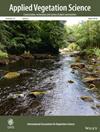Evaluation of Heat Shock Effects on Seedling Emergence and Seed Bank Viability in 18 Colombian Dry Forest Species
Abstract
Aim
High temperatures during forest fires can cause significant damage to tropical dry forest areas and alter their ecological stability, particularly by affecting seed viability and seedling emergence. This study evaluates the seedling emergence response of 18 dry forest species to fire-simulated temperatures, aiming to assess their potential for restoration in fire-prone Colombian ecosystems.
Location
The seeds used in this study were obtained from three tropical dry forests in Colombia.
Methods
A total of 9832 seeds from 18 dry forest species were collected directly from the soil seed bank in three tropical dry forests in Colombia. These seeds were then exposed to simulated forest fire temperatures (100°C, 150°C, and 200°C) for 10 min. Seed viability was analyzed using the 2,3,5-triphenyl tetrazolium chloride reagent (tetrazolium test) and assessed using a generalized linear model. Seedling emergence and mean emergence time were evaluated using one-way analysis of variance (ANOVA) with temperature treatments as factors.
Results
The study revealed that seedling emergence significantly decreased with higher heat shock temperatures. Notably, Hura crepitans and Parkinsonia aculeata tolerated temperatures up to 100°C, while Caesalpinia pulcherrima and Enterolobium cyclocarpum showed increased emergence at that temperature. Based on their emergence responses, species were classified as stimulated, tolerant, sensitive, or vulnerable. Seed viability declined with rising temperatures, and the mean emergence time increased in species like Cordia alba, Crescentia cujete, and Lonchocarpus violaceus.
Conclusions
This study shows that heat shocks at 150°C and 200°C significantly reduced seed bank viability for most Colombian dry forest species. However, Caesalpinia pulcherrima and Enterolobium cyclocarpum were stimulated by 100°C heat shocks, while Hura crepitans and Parkinsonia aculeata showed no adverse effects. Vulnerable species like Coccoloba acuminata and Pithecellobium dulce exhibited no viable seeds at higher temperatures, suggesting potential local extinctions. These results emphasize the need to focus on heat-tolerant species for restoration efforts in fire-prone ecosystems.

 求助内容:
求助内容: 应助结果提醒方式:
应助结果提醒方式:


